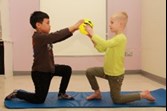Core stability
Core stability (also known as postural control) is the ability to control the position and movement of the central part of the body. This mainly involves the muscles in the trunk (stomach and back), shoulders and hips. These are necessary to help maintain good posture and give a stable base to allow controlled movements of the arms, legs, and head.
You can download this information below as a PDF.
Children and young people with decreased core stability may:
- Struggle to remain upright in their seat eg may slouch, fidget or lean on the table
- Struggle to stand without support so may lean on walls, furniture or other people
- Find it difficult to successfully complete some motor tasks eg walking for longer distances, balancing activities
- Have difficulties with functional activities eg dressing, handwriting, use of cutlery
- Demonstrate poor concentration and attention
- Curling into a ball
Lie on your back and place your arms across your chest. Bring your knees up towards your chest, now lift your head towards your knees. Hold this position for up to 30 seconds. - Bridging
Lie on your back with your knees bent and feet flat on the floor. Then, lift your bottom off the floor and hold for a few seconds. Return to starting position and repeat.
To make this more fun, try passing an object eg a ball, under and over your tummy.
- Aeroplane position
Lie on your tummy, then lift your arms and legs off the floor keeping them as straight as possible.
Try and hold for a few seconds and gradually increase to 30 seconds. - Balancing in four-point kneeling
Start on your hands and knees on the floor. Now lift an arm or leg keeping it straight in line with your body. Try and hold for a few seconds and gradually increase to 10 seconds. To make this more challenging, raise opposite arm and leg, see how long you can hold this position.
To make this more fun try throwing objects like bean bags at a target whilst maintaining your balance.
- Wall push ups
Standing facing a wall, take a step backwards, place your hands flat on the wall at shoulder height, and keep feet flat on the floor. Slowly bend elbows (keep your bottom tucked in/body straight) until your nose is almost touching the wall and now push away to return to starting position. Repeat 5-10 times. - Ball pass
Standing back to back with a partner, pass a medium sized ball either over your heads, between your legs or side to side.
Important points to consider:
Adult supervision is recommended for all gym ball activities.
Ensure the environment is free from other obstacles.
Gym ball should be 55cm diameter for younger children, and 65cm or 75cm for older children.
Make sure child/young person can sit on the gym ball with their hips and knees at a right angle and feet flat on the floor
- Rolling over the ball
Kneel in front of the gym ball. Place your tummy on the ball and walk forwards on your hands as far as you can, keeping your body straight. Now return to starting position, walking hands backwards. Do not rush or go too far forwards. Repeat 5-10 times. - Sitting and balancing
Sit on a gym ball with feet flat on floor and try the following:- Gently bounce up and down, keeping feet on the floor
- Move the ball using your bottom; side to side, back and forward, and in circles
- Lift alternate legs and maintain your balance
- Throw objects at a target while keeping your balance
- Bridging
Lying on the floor on your back, with arms by your side, place your legs on the gym ball. Now lift your bottom off the floor by straightening your legs, keep your feet on the ball see how long you can keep your balance.
Below are some other suggestions of activities that you can do with your child to help develop their core strength which can be incorporated into their play and daily activities.
- In a kneeling position:

- Play throwing and catching games.
- Play a board game at a low table.
- Drawing/ colouring or painting on an upright surface eg easel or paper on the wall.
- Log rolling:
Keep your body straight, with your arms either straight above your head or placed straight by your side. Roll to your left or right, see if you can do a full roll and repeat the other way. Make this more fun by trying to knock down some skittles. - Commando crawling:
Crawl keeping your tummy on the floor. - Animal walks:
- Dog: Crawling on your hands and knees. You could try racing someone, see how fast you can get from a start to a finish line.
- Bear: on your hands and feet with your bottom in the air, walk like a bear.
- Crab: Sit on the floor with your hands flat by your sides, bend your knees, now lift your bottom keeping your tummy up towards the ceiling and your feet flat on the floor. Now try and lift a leg, you could try kicking a ball at a goal. If able, see if you can walk in this position (backwards is easier).
- Sports and games:
Racket and ball games, swimming, trampolining, horse riding. - Playground equipment:
Encourage your child to explore different equipment eg climbing frame, rope ladder, swing etc. - Simple obstacle course:
Climbing over and under objects, commando crawling, crawling on hands and knees, walking along lines, throwing objects at a target in kneeling etc. - Soft play centres